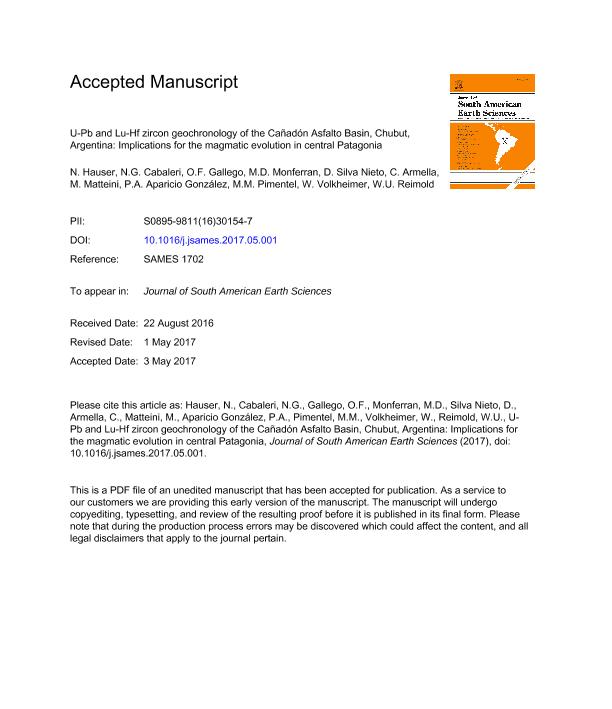Artículo
U-Pb and Lu-Hf zircon geochronology of the Cañadón Asfalto Basin, Chubut, Argentina: Implications for the magmatic evolution in central Patagonia
Hauser, Natalia ; Cabaleri, Nora Graciela
; Cabaleri, Nora Graciela ; Gallego, Oscar Florencio
; Gallego, Oscar Florencio ; Monferran, Mateo Daniel
; Monferran, Mateo Daniel ; Silva Nieto, Diego Gonzalo; Armella, Claudia
; Silva Nieto, Diego Gonzalo; Armella, Claudia ; Matteini, Massimo; Aparicio Gonzalez, Pamela Alejandra
; Matteini, Massimo; Aparicio Gonzalez, Pamela Alejandra ; Pimentel, Marcio; Volkheimer, Wolfang
; Pimentel, Marcio; Volkheimer, Wolfang ; Reimold, W. U.
; Reimold, W. U.
 ; Cabaleri, Nora Graciela
; Cabaleri, Nora Graciela ; Gallego, Oscar Florencio
; Gallego, Oscar Florencio ; Monferran, Mateo Daniel
; Monferran, Mateo Daniel ; Silva Nieto, Diego Gonzalo; Armella, Claudia
; Silva Nieto, Diego Gonzalo; Armella, Claudia ; Matteini, Massimo; Aparicio Gonzalez, Pamela Alejandra
; Matteini, Massimo; Aparicio Gonzalez, Pamela Alejandra ; Pimentel, Marcio; Volkheimer, Wolfang
; Pimentel, Marcio; Volkheimer, Wolfang ; Reimold, W. U.
; Reimold, W. U.
Fecha de publicación:
05/2017
Editorial:
Elsevier
Revista:
Journal of South American Earth Sciences
ISSN:
0895-9811
Idioma:
Inglés
Tipo de recurso:
Artículo publicado
Clasificación temática:
Resumen
The Cañadón Asfalto basin, central Chubut, Argentina, comprises a volcano-sedimentary sequence related to the opening of the Atlantic Ocean during Mesozoic times. The Lonco Trapial, Cañadón Asfalto and Cañadón Calcáreo formations are the main units related to the evolution of this basin. The Las Chacritas and Puesto Almada members are distinguished in the Cañadón Asfalto Formation. LA-HR-ICP-MS U-Pb and Lu-Hf data on zircon were obtained on these units. The Lonco Trapial Formation gave a weighted average age of 172.3±1.8 Ma. A pyroclastic level from the Las Chacritas Member gave a weighted average age of 168.2±2.2 Ma. Two U-Pb concordant ages of 160.3±1.7 Ma on a laminated tuffite and 158.3±1.3 Ma on a pyroclastic level were obtained for the Puesto Almada Member. Two maximum depositional ages constrain the sedimentary provenance areas for the basin: 1) A sample from the Sierra de la Manea range, where a controversial unit related either to the Cañadón Asfalto or to the Cañadón Calcáreo formation occurs, gave an age of 176.6±1.0 Ma. Two younger zircon crystals indicate that this unit may be related to the Cañadón Calcáreo Formation. 2) A sandstone with cross-stratification from the Puesto Almada Member gave a maximum depositional age of 173.6±6.4 Ma. In terms of U-Pb and Lu-Hf isotopes, two magmatic events are identified in central Patagonia: the Mamil Choique magmatic event characterized by negative εHf values around -5.0 and representing recycling during Permian times of Mesoproterozoic crust (TDM of ~1.5 Ga), and the Cañadón Asfalto magmatic event with negative (-8.2) to positive (+4) εHf values and Meso- to Neoproterozoic TDM between 1.5 and 0.8 Ga. The younger event is characterized by three main cycles: C1 related to the Lonco Trapial magmatism, C2 to the Las Chacritas volcanism, and C3 to the Puesto Almada volcanism. These cycles are related with Marifil, Chon Aike and El Quemado formations volcanics events of Patagonia and the Neuquén Basin during the Mesozoic.
Archivos asociados
Licencia
Identificadores
Colecciones
Articulos(CECOAL)
Articulos de CENTRO DE ECOLOGIA APLICADA DEL LITORAL (I)
Articulos de CENTRO DE ECOLOGIA APLICADA DEL LITORAL (I)
Citación
Hauser, Natalia; Cabaleri, Nora Graciela; Gallego, Oscar Florencio; Monferran, Mateo Daniel; Silva Nieto, Diego Gonzalo; et al.; U-Pb and Lu-Hf zircon geochronology of the Cañadón Asfalto Basin, Chubut, Argentina: Implications for the magmatic evolution in central Patagonia; Elsevier; Journal of South American Earth Sciences; 78; 5-2017; 190-212
Compartir
Altmétricas



